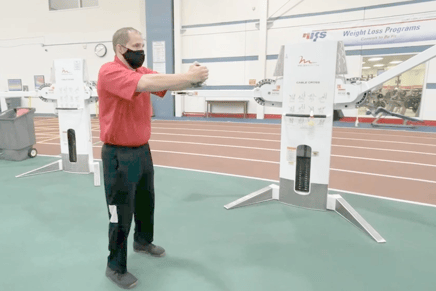 We all know that core stability and strength is an important factor in exercise, athletics, and even daily living. Being able to properly brace and stiffen the core is an important skill in preventing lower-back injuries when attempting certain movement patterns that occur every day. The abdominal crunch, which people often think of as a core exercise, is actually not a movement we see in our day-to-day lives. Try and think of a time you have had to mimic the abdominal crunch under a heavy load: it simply does not occur.
We all know that core stability and strength is an important factor in exercise, athletics, and even daily living. Being able to properly brace and stiffen the core is an important skill in preventing lower-back injuries when attempting certain movement patterns that occur every day. The abdominal crunch, which people often think of as a core exercise, is actually not a movement we see in our day-to-day lives. Try and think of a time you have had to mimic the abdominal crunch under a heavy load: it simply does not occur.
More often than not, we need to be stronger in the core in a more upright or natural standing posture. The abdominal crunch is now being found to stress the low-back area, can cause discomfort by compressing your back joints, and can even lead to injury after a while.
So you are probably wondering, how do I strengthen my core in an upright position? The answer is through anti-movement patterns. These could be anti-rotational, anti-flexion/extension, or anytime you are forcing your body to resist being moved from a normal posture. These patterns can be accomplished in an isometric hold or a dynamic pattern with bands, kettlebells, or weights.
Anti-rotational Exercise: The Paloff Press
An example of an anti-rotational exercise would be the Paloff press, shown here:
The goal is to press the handle from your belly button slowly and in a controlled manner so that the core has to work to not let your body turn.
Anti-Flexion or Extension Exercise: The Plank
An example of an anti-flexion or extension would be a plank, as shown here:
The goal is to keep your hips down and really engage the core area by pulling your belly button in. You can add weights to your back or increase the time you do these to make them more challenging!
Strengthening Exercise: The Kettlebell March
An example of strengthening the core in that normal standing position would be a kettlebell march, where you can either do two kettlebells in the front squat position or one held out in front. Both are shown here:
Marching slowly and controlled is the key for this exercise. While doing this, all the muscles in your core fire to prevent you from falling any direction while you balance on one leg.
See a NIFS Health Fitness Specialist to learn how you can start strengthening your core in a neutral position to assist with your exercises and your day-to-day life. See these links for more information:
ACSM core PowerPoint: http://forms.acsm.org/TPC/PDFs/23%20Best.pdf
PT Dr. Aaron Horschig: “The Big Three”: https://www.youtube.com/watch?v=2_e4I-brfqs
This blog was written by Grant Lamkin, NIFS Health Fitness Specialist. To learn more about the NIFS bloggers, click here.

